City Solicits Designs for Ellington School Renovation

By Eli OkunCurrent Correspondent
The upcoming renovation of the Duke Ellington School of the Arts — an estimated $82 million job that will require the school to relocate for two years — moved forward last month with an official invitation for architects to submit designs.
The renovation, part of the broader D.C. Public Schools modernization effort, will seek to update and enhance facilities that school officials described as out-of-date and insufficient.
The request for proposals issued by the D.C. Department of General Services calls for architects/engineers to submit plans by Aug. 7. The renovation is scheduled to take place over the 2013-14 and 2014-15 school years, according to the department’s Darrell Pressley, during which teachers and students will have to relocate to a not-yet-determined interim space.
The city will likely select an architectural firm for the renovation around Oct. 1, the start of the new fiscal year, said Ellington principal Rory Pullens.
By the time the Ellington community returns to its historic Burleith building in 2015, the upgrades will be a major boon, said Pullens. “This current facility is a historic landmark and ... it’s been here for over 100 years, and it was not initially designed as an art school,” he said. Ellington, at 3500 R St., was founded in 1974, but the building was constructed in 1898 and previously housed Western High School.
Today, many of the artistic facilities at the school are cramped. The music department, which comprises 40 percent of the student body, is confined to one floor, which can sometimes house more than 200 students at once. Choirs don’t have enough space to assemble fully, and students don’t have practice modules. “You find them all over the building practicing their particular instruments,” Pullens said.
The same is true of other artistic disciplines, he said. The museum studies department uses science classrooms during non-academic periods, while theater spills into math classrooms.
Many of the facilities problems’ are more elemental, said Charles Barber, president of the school’s board of directors. “On a very basic systems level, plumbing, air conditioning — those kinds of things need to be addressed,” Barber said.
Pullens noted that due to a lack of gas and running water in the science classrooms, the school has no labs.
Other desires for the renovated school include a black box theater and additional computer labs beyond the one that currently serves the entire school, Pullens said.
D.C. Public Schools has worked with Ellington in recent years to hire construction companies for smaller fixes, Pullens said. Davis Construction and other companies did “basically pro bono” work, he said, to renovate the lobby area, gallery space and student lockers. Other partners have stepped in, too: The Magic Johnson Foundation helped revamp the library, now a media center, and when roof problems allowed rain to damage dance floors, the Kennedy Center and others provided equipment to restore studios.
According to Barber, the planning effort is expected to be a yearlong process involving both the community and the school, as well as a to-be-determined advisory neighborhood commissioner.
Barber added that the process of selecting a space to house the school during the two years of renovation will be difficult, given the school’s dual needs. “For Ellington, we have a full academic program but we also have a full arts program, and so finding a space that has both ... will be a real challenge,” he said.
One factor in the renovation will be the Ellington building’s inclusion on the National Register of Historic Places. Changes will need to get approval from the U.S. Commission of Fine Arts, the Historic Preservation Review Board and the State Historic Preservation Office, Pressley said.
But given that most changes are planned for the school’s interior, Pullens said, the renovation should not infringe on the historic exterior.
Another possible change for Ellington is to expand enrollment from the current 500 students. Pullens said that idea has come under discussion, but would be feasible only if the school system commits to providing additional funding. “Can the school district commit to the additional personnel and resources that would be necessary to accommodate that larger number of students?” he asked.
This article appears in the Aug. 1 issue of The Georgetown Current newspaper.
